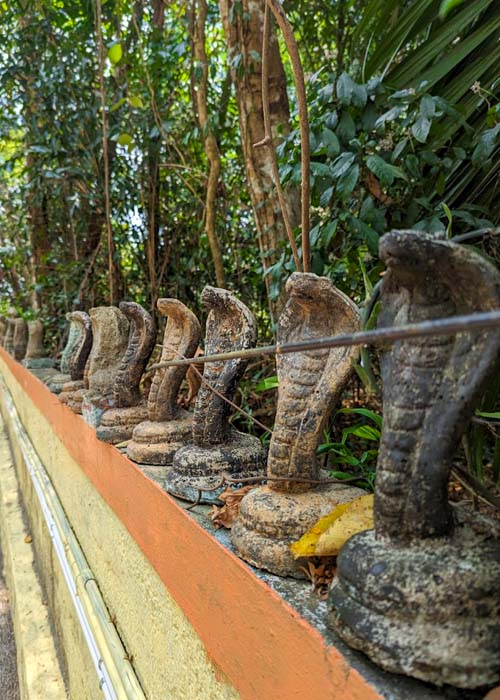
Loading

Loading
Ayilyam in the Kanni month (September-October) is known as Vetticode Ayilyam. On that day it is celebrated as the birthday of the deity. Special pujas and other special ceremonies start in the temple seven days before Ayilyam. On the day of Pooyam, the devotees consider it as a divine fortune to see the Deeparadhana of Nagaraja and Nagayakshi fully adorned by ornaments. After Deeparadhana, various instruments are played as offerings to the Lord. After closing the temple at 10 o'clock, Kathakali is performed outside the Kavu (sacred grove). On the Ayilyam day, after Nirmalya Darshan, Abhishekam, Usha Puja, Ucha Pooja, and Noorum Pal are performed, Nagaraja and Nagayakshi fully ornated are carried into the Illam at noon as a procession. It is widely known that those who see and pray during the procession will not have any fear of poisoning for a year. It is believed that after the poojas - in the Thevarappura – the deities are taken back into the temple with the hymns of the pulluvas. During the dusk, the most important ritual of 'Sarpa Bali’ happens. After 10 o'clock, after the Sarpa Bali, the temple is closed. On the day of the Makam, with the purification ritual - Ilaneerabhishekam (holy bathing of deities with tender coconut water) – the Ayilyam ceremonies come to an end. The same rituals are done again in the Ayilyam of Thulam month (October-November).

Deeparadhana and Athazha Pooja are held only during Pooyam and Ayilyam days in the months of Kanni and Thulam. Sundays are more important than ordinary days. A special puja called 'Noorum Palum' is performed on the Ayilyam days of every month. Also "Noorum Palum" is performed on every Sunday except Ekadashi from Ayilyam in Kanni month to Ayilyam in Edavam month. People come in large numbers to attend these functions. Ayilyam and Shivaratri days in Kumbham month and Balabhadrajayanti in Medam month are celebrated with special ceremonies.

Maha Shivaratri is celebrated annually in honor of Lord Shiva, one of the principal deities in Hinduism. The festival falls on the 14th night of the dark fortnight in the Hindu month of Phalguna, which typically falls in February or March in the Gregorian calendar.
The word "Maha Shivaratri" literally means "the great night of Shiva." It is believed that on this night, Lord Shiva performed the Tandava, a cosmic dance that signifies the cycle of creation, preservation, and destruction.
During Maha Shivaratri, devotees observe a day-long fast and offer prayers to Lord Shiva. They visit Shiva temples, perform rituals such as pouring milk over the Shiva lingam (a symbol of Lord Shiva), and chant mantras and hymns in his praise. The festival is particularly important for Shaivites, who are devotees of Lord Shiva, but it is also celebrated by Hindus from other sects.
